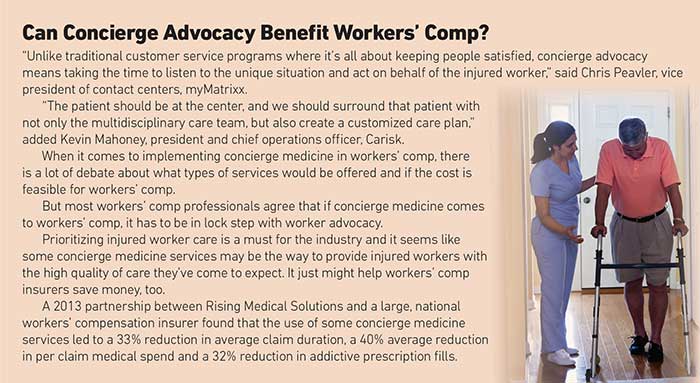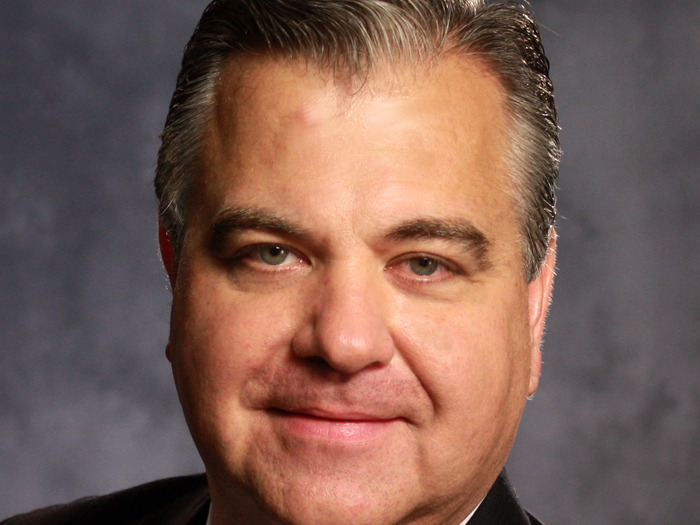Is Concierge Service a Realistic ‘Next Step’ for the Worker Advocacy Movement?

Amazon Prime offers two day shipping. Netflix, Hulu and other streaming services allow people to watch any movie or TV show whenever they want. Uber and Lyft mean cabs are just a few clicks away.
Today, people expect on-demand services, and that’s extending to on-demand medicine. In health care, concierge medicine endeavors to bring patients fast-tracked access to care through the use of on-demand doctors, new technologies and consumer-centric focus.
The superior quality of service promised by concierge doctors has some in workers’ compensation questioning whether the industry should lean into the worker advocacy movement by adopting a more patient-centric, consumer-oriented approach to care.
“You want the advocacy process to make you feel as if somebody’s taking care of you,” said John Peters, chief science officer for Gain Life Inc.
“You want injured workers to come away thinking, ‘You know, I really thought this was going to be horrible, but it turned out to be much better than I thought.’ You don’t want them walking away thinking, ‘This person is my enemy. This person is just trying to save money or trying to send me down a get-to-work- tomorrow path even if I might get re-injured, just because they don’t want me on the rolls.’ ”
While many, if not most, of the services concierge medicine offers aren’t realistic for the workers’ compensation system, adopting new technologies from the group health space could allow workers’ comp to double down on worker advocacy by creating a more on-demand, transparent approach to care.
Defining Concierge Advocacy
Within the workers’ compensation industry, there is some debate over what the term concierge advocacy means and what types of services it would entail.

Viviana Brantley, senior vice president of operations at myMatrixx
“It’s really putting that patient first and focusing on outcomes, and that is a paradigm shift for workers’ comp,” said Viviana Brantley, senior vice president of operations at myMatrixx.
“It’s not that we haven’t been focused on outcomes in terms of getting patients to return-to-work, but in the past, it’s been very much a reactive, retrospective, transactional process as opposed to proactive, holistic health management.”
“I really think that the underlying message of concierge advocacy is that we need to establish trust and show respect for the injured workers, whether it’s the claim handler, the case manager, the provider, anyone involved in the delivery of services,” added Tammy Bradly, vice president of clinical product development at Coventry.
“It’s the simple things of showing respect, building rapport, being timely in our responses back to the injured worker, whether we’re the doctor, again, the claims handler or even the clinical case management support.”
Even though the term seems analogous to concierge medicine, not everyone in the workers’ compensation industry sees it that way. Some consider it more akin to models like the biopsychosocial care movement, which prioritizes treating injured workers as individuals and considers how different aspects of their mental and physical health could be affecting their workers’ comp claims.
“For me, it means creating customized individual care plans for each injured worker based on their specific situation. This is not a one-size-fits-all kind of business, industry or single-threaded customer philosophy,” said Will Smith, chief commercial officer at One Call.
“If concierge-level advocacy implies that we’re paying greater attention to the needs of the patient, then we have to be considering all of their needs,” added Alana Letourneau, senior vice president of clinical strategy at Carisk. “That requires this biopsychosocial approach.”
A Feasible Next Step for Workers’ Comp?
Confusion exists over concierge advocacy in the industry, because many of the services that define concierge medicine in the group health space just aren’t realistic for workers’ compensation.
In group health, concierge medicine is often equated with paying a monthly or yearly fee to have a doctor on call for an individual or family. Concierge medicine patients take priority over other clients.
In workers’ comp, that kind of fast-tracked service isn’t fair or realistic.
“Let’s say there’s an employer that wants to pay us X amount of dollars to say that all our patients get first priority. That would be really tempting, but what happens when there’s two of its employees in our waiting room and somebody else comes with a nail in their foot? Do we honor the contract? Or do we take the person with the nail in their foot, because it’s much more serious?” said John deLorimier, EVP of customer growth and experience at Concentra.
“From a clinic standpoint, it is almost impossible to say that you’re going to have a concierge experience. We want to make sure that the patient has a good experience when they go through workers’ compensation, but it’s not the concierge service that people have in mind when they talk about the concierge medicine in the group health space.”

While some aspects of concierge medicine aren’t realistic for workers’ comp, others, such as the use of technology to give injured workers access to claims information and the patient advocacy attitude, can be brought into the industry. If even some of these services are adopted, it will mean major changes for workers’ compensation professionals and the system as a whole.
“The claims manager will become a health care manager,” Brantley said.
“The health care manager-patient relationship will be the new relationship of the future. So that patient management transitions to a nurse case manager as opposed to the more traditional claims manager.”
Claims managers and adjusters may find their roles are more similar to health care managers and the system may begin to seem more like a benefit than an indemnity.
“For me, it means creating customized individual care plans for each injured worker based on their specific situation. This is not a one-size-fits-all kind of business, industry or single-threaded customer philosophy.”— Will Smith, chief commercial officer, One Call
“A benefit feels like something is being offered to workers,” added Matthew Zender, senior vice president of workers’ compensation products at AmTrust.
“It’s something that is available to them, whereas an indemnity feels like it’s protecting them from something.”
To make these changes, trust will need to be developed and strengthened between workers’ compensation professionals and injured workers.
“Some of the changes will come down to trust on both sides. I think that the injured workers will have to trust that the system that is in place is truly looking out for their best interests, and I think that the system will have to trust that injured workers’ aren’t trying to take advantage of them,” Zender said.
“I think if that trust can exist it will allow for some pretty great things.”
Technology Drives Concierge-Like Services
One aspect of concierge medicine that can be applied to workers’ compensation is the use of technology to manage or aid in care. Self-service portals that enable injured workers to check the status of their claim, telemedicine services and virtual assistant apps can all help create a more individualized, patient-centric approach to care.
“I think of technology in today’s workers’ compensation environment as something that should serve really as a complement to a patient-centered comprehensive approach,” Letourneau said.

Will Smith, chief commercial officer, One Call
In workers’ compensation, technology can be used to create a concierge-like experience for injured workers by either creating access to more individualized, on-demand medical services or through improving communication. Some of these services include apps that manage and track patient care and automated text systems that enable claims managers to check in with injured workers.
“Communication is technology,” Smith said.
“We look at our phones. We get texts. We get alerts. We get pings. That’s the way of the world as far as communication — relevant and timely information shared as efficiently as possible. I had a customer say the only time I pick up my phone is to speak to people in the workers’ comp industry, which is pretty telling.”
Adopting these technologies can be a challenge for workers’ comp, however, as many in the industry still rely on out-dated forms of communication.
“Health care use faxes more than anything else, and that’s 1986 technology,” deLorimier said.
“In health care and workers’ comp, they still seem to be always trying to catch up, because technology in this space always brings worries about security. They’re super-focused on being exposed or hacked from the HIPAA standpoint.”
Injured workers may demand these kinds of changes even if workers’ comp isn’t ready to pursue them, Peters said, due to the expectations about service our culture has come to adopt.
“I think that has to be the future,” Peters said.
“I think the expectations people today have about service have really gone up. People like to feel like they’re being treated in the best way possible despite the unfortunate aspect of their injury.” &










